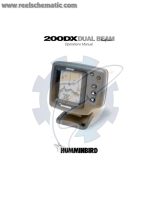
4
531870-1_E
Transducer Switch
© 2018 Johnson Outdoors Marine Electronics, Inc. All rights reserved.
5. Power Off
It is important to make sure all accessories (switches, control heads, etc.)
are powered off in order to avoid possibly draining the battery. To make
sure your Transducer Switch is disengaged, follow the steps below.
If your Transducer Switch is connected to the fuse panel:
1. Power off your boat to disengage the switch.
If your Transducer Switch is connected to a battery switch:
1. Turn the dial of the battery switch to the OFF position.
If your Transducer Switch is connected directly to a battery:
1. Power off your boat.
2. Remove the Transducer Switch wires from the battery.
Contact Humminbird
Web site humminbird.com
Telephone 1-800-633-1468
Direct Shipping Humminbird
Service Department
678 Humminbird Lane
Eufaula, AL 36027 USA
WARNING! This device should not be used as a navigational aid to prevent
collision, grounding, boat damage, or personal injury. When the boat is moving,
water depth may change too quickly to allow time for you to react. Always
operate the boat at very slow speeds if you suspect shallow water or submerged
objects.
WARNING! Disassembly and repair of this electronic unit should only be
performed by authorized service personnel. Any modification of the serial
number or attempt to repair the original equipment or accessories by
unauthorized individuals will void the warranty.
ENVIRONMENTAL COMPLIANCE STATEMENT: It is the intention of Johnson
Outdoors Marine Electronics, Inc. to be a responsible corporate citizen, operating
in compliance with known and applicable environmental regulations, and a good
neighbor in the communities where we make or sell our products.
WEEE Directive: EU Directive 2002/96/EC “Waste of Electrical and Electronic
Equipment Directive (WEEE)” impacts most distributors, sellers, and
manufacturers of consumer electronics in the European Union. The WEEE
Directive requires the producer of consumer electronics to take responsibility for
the management of waste from their products to achieve environmentally
responsible disposal during the product life cycle.
WEEE compliance may not be required in your location for electrical & electronic
equipment (EEE), nor may it be required for EEE designed and intended as fixed
or temporary installation in transportation vehicles such as automobiles, aircraft,
and boats. In some European Union member states, these vehicles are
considered outside of the scope of the Directive, and EEE for those applications
can be considered excluded from the WEEE Directive requirement.
This symbol (WEEE wheelie bin) on product indicates the product must
not be disposed of with other household refuse. It must be disposed of
and collected for recycling and recovery of waste EEE. Johnson Outdoors
Marine Electronics, Inc. will mark all EEE products in accordance with
the WEEE Directive. It is our goal to comply in the collection, treatment, recovery,
and environmentally sound disposal of those products; however, these
requirements do vary within European Union member states. For more
information about where you should dispose of your waste equipment for
recycling and recovery and/or your European Union member state requirements,
please contact your dealer or distributor from which your product was purchased.




